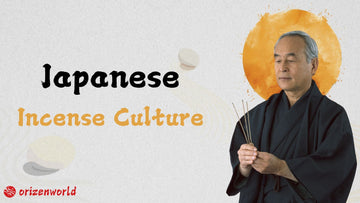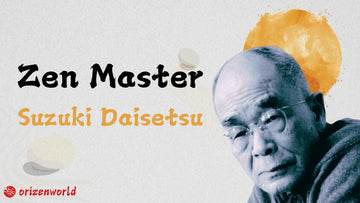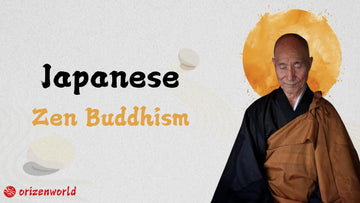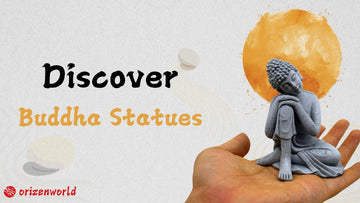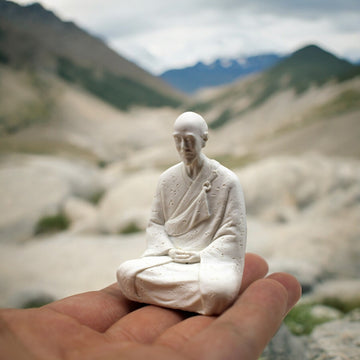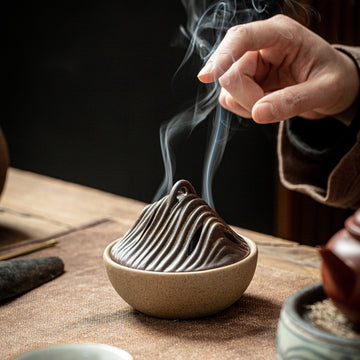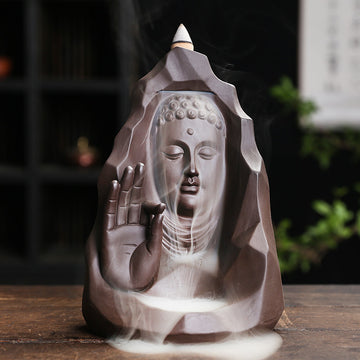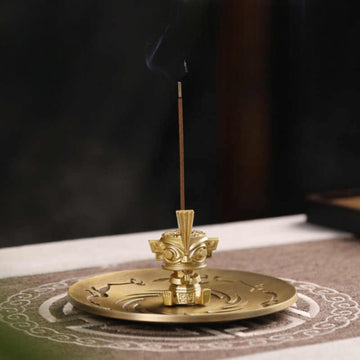Believe it or not, the first time I encountered incense was through a Japanese anime called Gintama. In one episode, the protagonist, Sakata Gintoki, visits a temple and holds incense to pray for luck and to ward off misfortune. Since then, I’ve associated incense with Japanese culture. Being passionate about all things Japanese, I quickly grew to appreciate incense culture. It’s truly wonderful, bringing harmony and peace to our chaotic lives, which has been incredibly helpful to me. That’s why I’m excited to share this blog post.
In today’s article, I’ll take you through everything I know about Japanese incense culture. I hope you’ll join me!
Japanese incense culture has deep roots in China and India, much like many aspects of Japanese culture. Incense arrived in Japan alongside Buddhism, which spread from China and India. This cultural exchange can be traced back to 753 AD when Master Jianzhen successfully traveled to Japan, bringing Buddhist teachings and Chinese incense traditions with him. Buddhism played a significant role in shaping Japan's incense culture, especially in religious ceremonies and rituals.

Jianzhen (688-763) was a renowned Tang Dynasty Buddhist monk and the founder of Japan's Ritsu school. Born in Yangzhou, China, he became an influential figure in Buddhist law. In 742, Japan's imperial court invited him to teach true Buddhist practices. Despite numerous failed attempts, Jianzhen successfully crossed the sea after 11 years in 754. His teachings greatly impacted Japan’s Buddhist system, especially the establishment of the Ritsu school, shaping monastic practices for centuries.
During the Nara period in Japan, incense filled Buddhist temples and even royal court ceremonies, creating an atmosphere of calm and reverence. The fragrant smoke was believed to purify the air and connect people with the divine. As time passed, during the Heian period, incense culture began to extend beyond temples into the daily lives of the Japanese aristocracy. The nobility adopted incense practices, holding “kōkai” (incense gatherings) to enjoy and appreciate the subtle art of incense.
By the Edo period, Japanese incense culture had evolved into kōdō (the Way of Incense), a refined practice that became part of the cultural elite's lifestyle. It was considered one of the "Three Elegant Ways" alongside the tea ceremony and flower arranging, becoming an essential cultural pursuit for Japan's upper class. Over centuries, incense has become not only a spiritual tool but a symbol of grace, mindfulness, and harmony.
Kōdō, often referred to as the "Way of Incense," is a traditional Japanese practice that focuses on the appreciation and ceremonial use of incense. Like the tea ceremony (chanoyu), kōdō has evolved into an important cultural art form. It revolves around the refined appreciation of incense, emphasizing the spiritual and meditative experience. The practice involves not just the scent but also the atmosphere, aesthetics, and interaction with the incense, creating a serene and contemplative environment.

Incense appreciation ceremonies and games, such as "Kōdō-kō" or "Incense Appreciation," are central to the practice. Participants use various forms of incense, including incense powder, incense sticks, coils, and cones, which have become the dominant forms in contemporary practice. During these ceremonies, participants engage in competitions to identify different scents or rank the quality of the incense used, creating a harmonious blend of sensory perception and mindfulness.
Several unique tools are used in kōdō rituals, each with its specific function. For example, the gin'you is used for picking up silver leaves, while the kō-shi is a spoon for scooping incense powder or small pieces of incense wood. The kō-bashi (incense chopsticks) are used to mix incense powder or handle incense wood, and tō (small pins) hold incense bags in place. Other tools include the hane-bō (a small broom for sweeping ash) and hi-bashi (fire tongs) used to handle hot charcoal and incense materials. These tools are integral to maintaining the ritual's precision and beauty.

In Japan, incense comes in various forms, each with unique characteristics that suit different purposes and occasions. Stick incense (senkō) is the most common and widely used type. Its simplicity and convenience make it ideal for daily use, as it can be easily lit and provides a steady, gentle fragrance. Many Japanese households use stick incense for personal relaxation, meditation, or to create a pleasant atmosphere during daily rituals.
Cone incense is more concentrated than stick incense, offering a stronger scent. It is often used in ceremonial settings or for special occasions, as the burning of a cone produces a richer, more intense fragrance. The compact shape of the cones makes them ideal for use in incense holders designed for ceremonial purposes, providing an enhanced sensory experience. Cone incense is frequently seen in religious or spiritual rituals in temples or shrines.
Coil incense is designed to burn for an extended period, making it perfect for meditative practices. When lit, the coil creates a continuous stream of smoke, contributing to a serene and peaceful environment. This type of incense is commonly used during meditation or traditional gatherings, where the lingering fragrance can help deepen the experience. Lastly, kneaded incense (nerikō) is an artistic and luxurious type of incense, often shaped by hand into intricate designs. It is typically used in formal settings or during refined ceremonies, offering a sophisticated and high-quality aromatic experience.
In Japan, incense holds deep cultural and spiritual significance, especially in religious practices. Incense use in temples, shrines, and meditation is central to creating a tranquil atmosphere conducive to spiritual reflection. For instance, in a Zen garden, Zen masters often burn incense during meditation sessions, using the scent to enhance the peaceful, mindful environment. The aroma is believed to clear the mind, help with focus, and bring practitioners closer to a state of inner peace and enlightenment.
Incense as an offering also carries symbolic meaning in Japanese culture. It is commonly used in religious ceremonies and prayers, where the burning incense symbolizes the purification of both the space and the individuals present. Offering incense is seen as a way to connect with deities, show reverence, and seek blessings. The rising smoke is thought to carry prayers to the heavens, symbolizing the purification of thoughts and actions, which is essential in Japanese spiritual practices.

Beyond religion, incense has significantly influenced Japanese poetry, art, and aesthetics. In classic works such as The Tale of Genji (源氏物语), incense plays a role in portraying the lives of the noble class. Aristocratic men and women were known to use incense in a competitive manner, with the scent of their incense infused into their clothes. This practice represented status and taste, adding to the allure and elegance of the time.
Japan is renowned for its centuries-old tradition of incense production, with many of its most famous incense brands having deep historical roots. These regions have cultivated a deep connection between incense making and spiritual practices, particularly in Buddhism.
Kyoto is considered the heart of traditional Japanese culture, and its incense production is integral to this legacy. Famous incense brands such as Shoyeido and Kyukyodo have been creating high-quality incense for centuries. The city's long history of incense making is closely tied to its many Buddhist temples and shrines, where incense is used in religious ceremonies and rituals. Kyoto's incense often reflects the elegance and simplicity of traditional Japanese aesthetics.

Aichi Prefecture (Nagoya) is another important incense-producing region in Japan. Known for brands like Baieido, Aichi has been producing incense for both ceremonial and everyday use. The region is known for its blend of traditional incense-making methods with modern innovations, appealing to a wide range of incense enthusiasts.
Kōyasan (Mount Kōya), a sacred Buddhist site, also produces incense with significant spiritual value. The incense from this region is used in temple ceremonies to enhance meditation and prayer, offering a connection between the physical and spiritual realms.
Lastly, Kamakura, known for its temples and Zen gardens, produces incense with a more refined and meditative fragrance, often sought after by those who value peace and tranquility.
Origins and Historical Development
Japanese incense culture originated from the spread of Buddhism from China and India. During the Tang Dynasty, the monk Jianzhen introduced incense culture to Japan, where it gradually integrated into religious and aristocratic practices, eventually evolving into the unique Japanese art of Kōdō (The Way of Incense).
In contrast, Chinese incense culture has a much longer history, tracing back to the Zhou Dynasty. It was initially used for religious rituals, medical purposes, and daily life, later becoming an important cultural symbol for scholars and literati.
Usage and Forms
Japanese incense culture centres on Kōdō, which emphasises ritualistic and spiritual experiences. It focuses on appreciating scents through structured ceremonies and the use of specialised tools like incense spoons and tweezers. The process is elegant and meticulous.
Chinese incense culture, however, is more versatile in its applications, ranging from religious offerings and aromatising clothes to creating a peaceful home environment.
Chinese incense forms are diverse, including powders, cakes, and carved agarwood pieces, showcasing its functional and artistic flexibility.
Cultural Spirit and Aesthetics
Japanese incense culture highlights Zen principles of harmony and tranquillity, aiming to achieve inner peace and balance. It plays a vital role in Japan’s “Three Noble Arts” (tea ceremony, flower arranging, and incense appreciation). Conversely, Chinese incense culture is heavily influenced by Confucianism and Daoism, expressing the unity of humanity and nature while valuing the rarity and complexity of fragrances. Modern Japanese incense remains an art form, while Chinese incense, although seeing a revival, is primarily preserved as a cultural heritage.
When selecting high-quality Japanese incense, focus on the ingredients and craftsmanship. Premium incense is typically made from natural materials like sandalwood, aloeswood, or floral essences. Avoid products with synthetic additives, as they can detract from the authentic experience.
Trusted brands often provide detailed descriptions of their ingredients and production methods, ensuring you get a genuine product. Consider the purpose of your incense—whether for relaxation, meditation, or creating a peaceful ambiance—and choose a scent profile that aligns with your needs.
Creating a personal incense ritual can be a rewarding experience. Begin by selecting a suitable incense holder or burner that complements your space. Light the incense, allowing the delicate aroma to fill the room, and use this moment to centre yourself. Incorporating incense into daily practices like meditation, yoga, or journaling can enhance the atmosphere and promote mindfulness. Experiment with different types of incense, such as sticks, cones, or coils, to discover what suits your preferences.
Popular Japanese incense brands, including Shoyeido, Nippon Kodo, and Baieido, are renowned for their quality and variety. These brands often blend traditional techniques with modern innovations. You can find their products in specialty stores, online retailers, or during visits to Japan, where local shops may offer unique, handcrafted options for a truly authentic experience.

